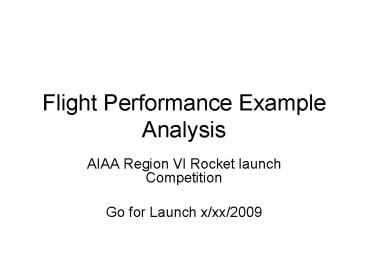Flight Performance Example Analysis PowerPoint PPT Presentation
1 / 18
Title: Flight Performance Example Analysis
1
Flight Performance Example Analysis
- AIAA Region VI Rocket launch Competition
- Go for Launch x/xx/2009
2
Topics
- Competition Rules
- Scoring
- Use of Simulators
- Example Analysis
3
Competition Rules
- Each section shall have only one team unless
there are kits left over after the registration
closing date. - Teams must primarily be formed by Young
Professionals (under 35 and less then 6 years
degreed). - Teams will produce monthly reports discussing
their rocket design and construction progress. - Teams must provide a payload bay for an IMU and
parachute deployment system (provided) - Simulators (Rocsim, etc.) may be used but only
the numbers from the manual analyses will be
excepted.
4
Scoring
- The competition will have two winning categories.
- Overall highest altitude
- Overall best flight performance
- In the altitude category, the team with the
rocket that flies the highest wins! - In the flight performance category, the winning
team will have produced the launch vehicle that
integrates the payload well, is the most stable
in flight, and best matches its predicted
performance numbers. - One team can win both categories if their launch
vehicle performs as required.
5
Scoring
- Payload The AIAA AV section is hosting and will
provide an IMU and parachute deployment system.
A means of easily installing this payload prior
to launch must be provided. - Stability 0 to 100 - Perfect stability
resulting in a rocket that does not wobble in
flight verses a CRASH - Stability will be measured by the IMU.
6
Scoring
- Predicted Performance Eight parameters will be
considered, each scored with 0 to 10 points on a
percentage basis. - 0 to 5 match 0 points
- 5.01 to 15 1 point
- 15.01 to 25 2 points
- 25.01 to 35 3 points
- 35.01 to 45 4 points
- 45.01 to 55 5 points
- 55.01 to 65 6 point
- 65.01 to 75 7 points
- 75.01 to 85 8 points
- 85.01 to 95 9 points
- 95.01 to 100 10 points
7
Scoring
- Payload must not take more then 30 minutes to
install - Scored parameters include
- Burnout Delta V
- X Velocity (Average Percentage Throughout Flight)
- Y Velocity (Average Percentage Throughout Flight)
- Burnout Altitude
- Time at Zenith
- Max Altitude
- Terminal Acceleration
- Down Range Distance
8
Scoring
- Scoring Formula Final scores will be calculated
with the following formula.
9
Performance Analysis
- The following charts show an example launch
performance analysis. This analysis is close but
not accurate to the kits, engines, hardware and
payload provided. Each team must work out their
own analysis.
10
Rocket Engine Data
- Rocket Body with parachute
- Stage 1 2 SSMEs 356 seconds
- Stage 2 No engines, fuel tank release
11
Example AnalysisProperties
- SSME Parameters
- Initial Mass 8.3 kg
- Final Mass 7 kg
- Total burn time 8 seconds
- Isp 150 seconds
12
Example Analysis Mass Flow
13
Example Analysis Delta V
14
Example Analysis X Y Velocites
X Y Velocity Components
15
Example Analysis Altitude Time
Burnout altitude
Time at zenith
16
Example Analysis Zenith Altitude
Zenith altitude
17
Example Analysis Terminal Acceleration and Energy
Terminal acceleration (maximum)
Energy at Burnout
18
SSME FlightReferences
- Sutton, G.P., Rocket Propulsion Elements,
Seventh Edition, 2007, Wiley-Interscience, New
York - Humble, R.W., Space Propulsion Analysis and
Design, 1995, McGraw Hill

